
Featuring career information from Brian Hicks, Systems Manager at Skyward
- Subject:
- Business and Information Technology
- Career and Technical Education
- Computer Science
- Material Type:
- Other
- Author:
- NWTC
- CESA 8
- Date Added:
- 01/12/2023

Featuring career information from Brian Hicks, Systems Manager at Skyward
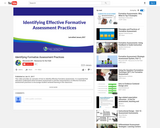
This video tutorial will help you identify effective formative practices. In order to improve student outcomes, it is essential that educators understand what the formative assessment process is and the characteristics of effective formative assessment practices.

Digital Literacy and Responsibility. The student will learn new skills for using technology in productive, creative, and responsible ways. They will use the skills to help themselves and others in their world to make good decisions about technology. (Description taken from site, retrieved on May,3, 2016)
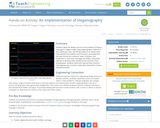
Students apply the design process to the problem of hiding a message in a digital image using steganographic methods, a PictureEdit Java class, and API (provided as an attachment). They identify the problems and limitations associated with this task, brainstorm solutions, select a solution, and implement it. Once their messages are hidden, classmates attempt to decipher them. Based on the outcome of the testing phase, students refine and improve their solutions.
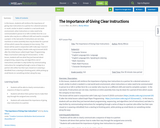
In this lesson, students will reinforce the importance of giving clear instructions to a partner for a desired outcome or result, similar to what is needed in a real world work environment, when instructions or notes need to be communicated in person to or left in written form for a co-worker who may be on a different shift and need to complete a project. In the real world, if instructions are not clear, machines or entire assembly lines may be down for a period of time which causes the company to lose money.
This lesson will be used in conjunction with Code.org's Course D (2019) curriculum (https://studio.code.org/s/coursed-2019) after the initial lesson called Graph Paper Programming - https://curriculum.code.org/csf-19/coursed/1/. In this lesson, students will use what they just learned about programming, sequencing, and algorithms (set of instructions) and take it a step further by communicating instructions for navigating through a series of steps to a partner who either has their eyes closed (or is wearing a blindfold) from a starting to finishing point, while picking up small blocks (or something similar) along the way.
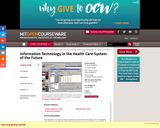
"This innovative, trans-faculty subject teaches how information technologies (IT) are reshaping and redefining the health care marketplace through improved economies of scale, greater technical efficiencies in the delivery of care to patients, advanced tools for patient education and self-care, network integrated decision support tools for clinicians, and the emergence of e-commerce in health care. Student tutorials provide an opportunity for interactive discussion. Interdisciplinary project teams comprised of Harvard and MIT graduate students in medicine, business, law, education, engineering, computer science, public health, and government collaborate to design innovative IT applications. Projects are presented during the final class. ĺĘ Starting in Spring 2010, this course will be titled Enabling Technology Innovation in Healthcare and the Life Sciences."
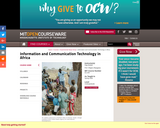
This is a discussion-based, interactive seminar on the development of information and communication technology in Sub-Saharan Africa. The students will seek to understand the issues surrounding designing and instituting policy, and explore the possible ways in which they can make an impact on information and communication technology in Africa.
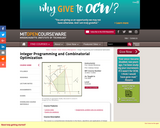
The course is a comprehensive introduction to the theory, algorithms and applications of integer optimization and is organized in four parts: formulations and relaxations, algebra and geometry of integer optimization, algorithms for integer optimization, and extensions of integer optimization.
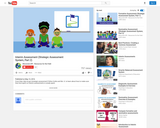
This video and resources can be used to support educators' professional development related to assessment literacy. Consider using the supplement to kick off your next PLC meeting to enhance your own assessment literacy.
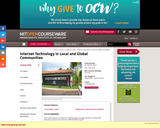
This course is based on the work of the MIT-African Internet Technology Initiative (MIT-AITI). MIT-AITI is an innovative approach by MIT students to integrate computers and internet technology into the education of students in African schools. The program focuses upon programming principles, cutting-edge internet technology, free open-source systems, and even an entrepreneurship seminar to introduce students in Africa to the power of information technology in today's world. MIT-AITI achieves this goal by sending MIT students to three African nations in order to teach both students and teachers through intensive classroom and lab sessions for six weeks. The AITI program is implemented with emphasis on classroom teaching, community-oriented projects, and independent learning. This course has two major components: Content from a spring 2005 preparatory seminar offered by the MIT-AITI leadership. The goal of this seminar is to adequately prepare the AITI student teachers for their upcoming summer experiences in Africa. A snapshot of the summer 2005 MIT-AITI program. This includes the Javaĺ¨-based curriculum that MIT-AITI ambassadors teach in Africa each year, as well as content from an entrepreneurship seminar offered concurrently with the IT class.
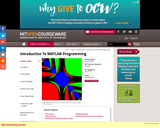
This course is intended to assist undergraduates with learning the basics of programming in general and programming MATLAB in particular.
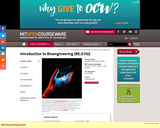
Designed as a freshmen seminar course, faculty from various School of Engineering departments describe the research and educational opportunities specific to and offered by their departments. Background lectures by the 20.010J staff introduce students to the fundamental scientific basis for bioengineering. Specially produced videos provide additional background information that is supplemented with readings from newspaper and magazine articles. Bioengineering at MIT is represented by the diverse curricula offered by most Departments in the School of Engineering. This course samples the wide variety of bioengineering options for students who plan to major in one of the undergraduate Engineering degree programs. The beginning lectures describe the science basis for bioengineering with particular emphasis on molecular cell biology and systems biology. Bioengineering faculty will then describe the bioengineering options in a particular engineering course as well as the type of research conducted by faculty in the department.

This is a fast-paced introductory course to the C++ programming language. It is intended for those with little programming background, though prior programming experience will make it easier, and those with previous experience will still learn C++-specific constructs and concepts. This course is offered during the Independent Activities Period (IAP), which is a special 4-week term at MIT that runs from the first week of January until the end of the month.
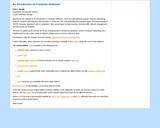
Welcome to the website for An Introduction to Computer Networks, a free and open general-purpose computer-networking textbook, complete with diagrams and exercises. It covers the LAN, internetworking and transport layers, focusing primarily on TCP/IP. Particular attention is paid to congestion; other special topics include queuing, real-time traffic, network management, security and the ns simulator.
The book is suitable as the primary text for an undergraduate or introductory graduate course in computer networking, as a supplemental text for a wide variety of network-related courses, and as a reference work.
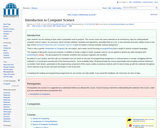
Dear student! You are starting to learn about computation and its purpose. This course covers the same materials as an introductory class for undergraduate computer science majors. Its curriculum, which includes software, hardware and algorithms, resembles that of a one- or two-semester first-year college course or the high school Advanced Placement (AP) Computer Science. It does not require a formal computer science background.
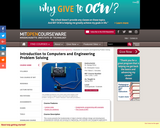
This course presents the fundamentals of object-oriented software design and development, computational methods and sensing for engineering, and scientific and managerial applications. It cover topics, including design of classes, inheritance, graphical user interfaces, numerical methods, streams, threads, sensors, and data structures. Students use Java programming language to complete weekly software assignments. How is 1.00 different from other intro programming courses offered at MIT? 1.00 is a first course in programming. It assumes no prior experience, and it focuses on the use of computation to solve problems in engineering, science and management. The audience for 1.00 is non-computer science majors. 1.00 does not focus on writing compilers or parsers or computing tools where the computer is the system; it focuses on engineering problems where the computer is part of the system, or is used to model a physical or logical system. 1.00 teaches the Java programming language, and it focuses on the design and development of object-oriented software for technical problems. 1.00 is taught in an active learning style. Lecture segments alternating with laboratory exercises are used in every class to allow students to put concepts into practice immediately; this teaching style generates questions and feedback, and allows the teaching staff and students to interact when concepts are first introduced to ensure that core ideas are understood. Like many MIT classes, 1.00 has weekly assignments, which are programs based on actual engineering, science or management applications. The weekly assignments build on the class material from the previous week, and require students to put the concepts taught in the small in-class labs into a larger program that uses multiple elements of Java together.
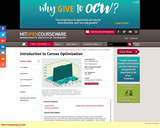
This course aims to give students the tools and training to recognize convex optimization problems that arise in scientific and engineering applications, presenting the basic theory, and concentrating on modeling aspects and results that are useful in applications. Topics include convex sets, convex functions, optimization problems, least-squares, linear and quadratic programs, semidefinite programming, optimality conditions, and duality theory. Applications to signal processing, control, machine learning, finance, digital and analog circuit design, computational geometry, statistics, and mechanical engineering are presented. Students complete hands-on exercises using high-level numerical software. Acknowledgements The course materials were developed jointly by Prof. Stephen Boyd (Stanford), who was a visiting professor at MIT when this course was taught, and Prof. Lieven Vanderberghe (UCLA).
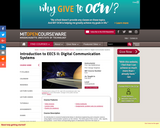
An introduction to several fundamental ideas in electrical engineering and computer science, using digital communication systems as the vehicle. The three parts of the course - bits, signals, and packets - cover three corresponding layers of abstraction that form the basis of communication systems like the Internet. The course teaches ideas that are useful in other parts of EECS: abstraction, probabilistic analysis, superposition, time and frequency-domain representations, system design principles and trade-offs, and centralized and distributed algorithms. The course emphasizes connections between theoretical concepts and practice using programming tasks and some experiments with real-world communication channels.
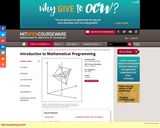
This course is an introduction to linear optimization and its extensions emphasizing the underlying mathematical structures, geometrical ideas, algorithms and solutions of practical problems. The topics covered include: formulations, the geometry of linear optimization, duality theory, the simplex method, sensitivity analysis, robust optimization, large scale optimization network flows, solving problems with an exponential number of constraints and the ellipsoid method, interior point methods, semidefinite optimization, solving real world problems problems with computer software, discrete optimization formulations and algorithms.
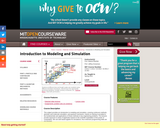
This subject provides an introduction to modeling and simulation, covering continuum methods, atomistic and molecular simulation, and quantum mechanics. Hands-on training is provided in the fundamentals and applications of these methods to key engineering problems. The lectures provide exposure to areas of application based on the scientific exploitation of the power of computation. We use web based applets for simulations, thus extensive programming skills are not required.